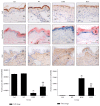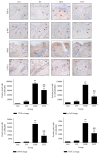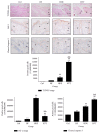Hataedock Treatment Has Preventive Therapeutic Effects in Atopic Dermatitis-Induced NC/Nga Mice under High-Fat Diet Conditions
- PMID: 27313639
- PMCID: PMC4894994
- DOI: 10.1155/2016/1739760
Hataedock Treatment Has Preventive Therapeutic Effects in Atopic Dermatitis-Induced NC/Nga Mice under High-Fat Diet Conditions
Abstract
This study investigated the preventive therapeutic effects of Hataedock (HTD) treatment on inflammatory regulation and skin protection in AD-induced NC/Nga mice under high-fat diet conditions. Before inducing AD, the extract of Coptidis Rhizoma and Glycyrrhiza uralensis was administered orally to the 3-week-old mice. After that, AD-like skin lesions were induced by applying DNFB. All groups except the control group were fed a high-fat diet freely. We identified the effects of HTD on morphological changes, cytokine release and the induction of apoptosis through histochemistry, immunohistochemistry, and TUNEL assay. HTD downregulated the levels of IL-4 and PKC but increased the levels of LXR. HTD also suppressed the mast cell degranulation and release of MMP-9, Substance P. The levels of TNF-α, p-IκB, iNOS, and COX-2 were also decreased. The upregulation of inflammatory cell's apoptosis is confirmed by our results as increase of apoptotic body and cleaved caspase-3 and decrease of Bcl-2. HTD also reduced edema, angiogenesis, and skin lesion inflammation. Our results indicate HTD suppresses various inflammatory response on AD-induced mice with obesity through the regulation of Th2 differentiation and the protection of lipid barrier. Therefore, HTD could be used as an alternative and preventive therapeutic approach in the management of AD.
Figures








Similar articles
-
Hataedock treatment has preventive therapeutic effects for atopic dermatitis through skin barrier protection in Dermatophagoides farinae-induced NC/Nga mice.J Ethnopharmacol. 2017 Jul 12;206:327-336. doi: 10.1016/j.jep.2017.06.001. Epub 2017 Jun 3. J Ethnopharmacol. 2017. PMID: 28583294
-
Douchi (fermented Glycine max Merr.) alleviates atopic dermatitis-like skin lesions in NC/Nga mice by regulation of PKC and IL-4.BMC Complement Altern Med. 2016 Oct 24;16(1):416. doi: 10.1186/s12906-016-1394-4. BMC Complement Altern Med. 2016. PMID: 27776525 Free PMC article.
-
Effect of Hataedock Treatment on Epidermal Structure Maintenance through Intervention in the Endocannabinoid System.Evid Based Complement Alternat Med. 2020 Jan 22;2020:3605153. doi: 10.1155/2020/3605153. eCollection 2020. Evid Based Complement Alternat Med. 2020. PMID: 32063982 Free PMC article.
-
Gardenia jasminoides extract without crocin improved atopic dermatitis-like skin lesions via suppression of Th2-related cytokines in Dfe-induced NC/Nga mice.J Ethnopharmacol. 2019 Sep 15;241:112015. doi: 10.1016/j.jep.2019.112015. Epub 2019 Jun 4. J Ethnopharmacol. 2019. PMID: 31173875
-
The Role of Proteasome Inhibitor MG132 in 2,4-Dinitrofluorobenzene-Induced Atopic Dermatitis in NC/Nga Mice.Int Arch Allergy Immunol. 2018;176(2):91-100. doi: 10.1159/000488155. Epub 2018 Apr 18. Int Arch Allergy Immunol. 2018. PMID: 29669333
Cited by
-
Inhibitory Effect of Carnosol on Phthalic Anhydride-Induced Atopic Dermatitis via Inhibition of STAT3.Biomol Ther (Seoul). 2017 Sep 1;25(5):535-544. doi: 10.4062/biomolther.2017.006. Biomol Ther (Seoul). 2017. PMID: 28655070 Free PMC article.
-
Management of Atopic Dermatitis Via Oral and Topical Administration of Herbs in Murine Model: A Systematic Review.Front Pharmacol. 2022 May 24;13:785782. doi: 10.3389/fphar.2022.785782. eCollection 2022. Front Pharmacol. 2022. PMID: 35685636 Free PMC article.
-
Combined Oral and Topical Application of Pumpkin (Cucurbita pepo L.) Alleviates Contact Dermatitis Associated With Depression Through Downregulation Pro-Inflammatory Cytokines.Front Pharmacol. 2021 May 10;12:663417. doi: 10.3389/fphar.2021.663417. eCollection 2021. Front Pharmacol. 2021. PMID: 34040528 Free PMC article.
-
Impact of Nutritional Supplementation on Canine Dermatological Disorders.Vet Sci. 2020 Apr 3;7(2):38. doi: 10.3390/vetsci7020038. Vet Sci. 2020. PMID: 32260299 Free PMC article. Review.
-
Inhibitory effect of Carnosol on UVB-induced inflammation via inhibition of STAT3.Arch Pharm Res. 2019 Mar;42(3):274-283. doi: 10.1007/s12272-018-1088-1. Epub 2018 Nov 15. Arch Pharm Res. 2019. PMID: 30430364 Free PMC article.
References
-
- Danby S., Cork M. J. A new understanding of atopic dermatitis: the role of epidermal barrier dysfunction and subclinical inflammation. Journal of Clinical Dermatology. 2012;1:33–46.
LinkOut - more resources
Full Text Sources
Other Literature Sources
Research Materials
Miscellaneous

